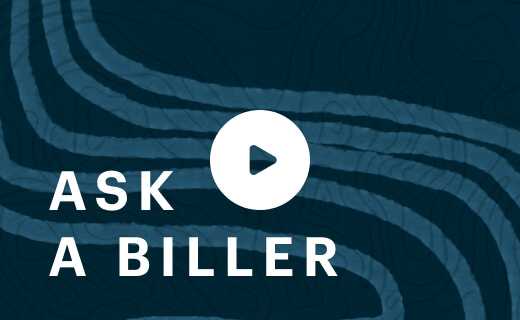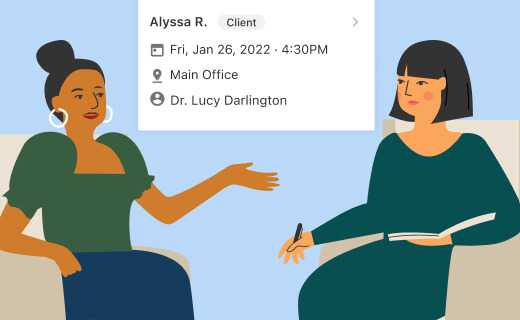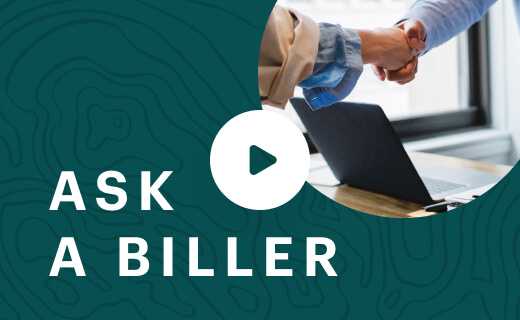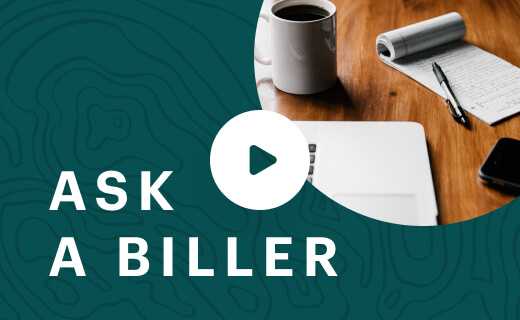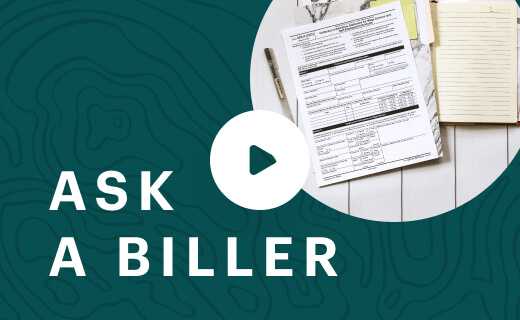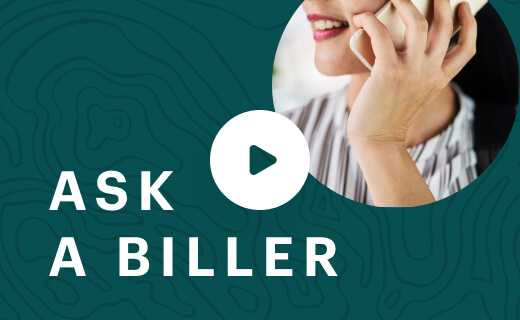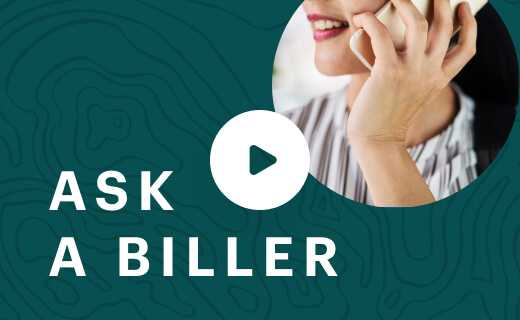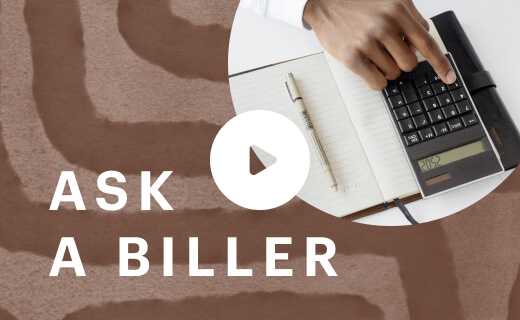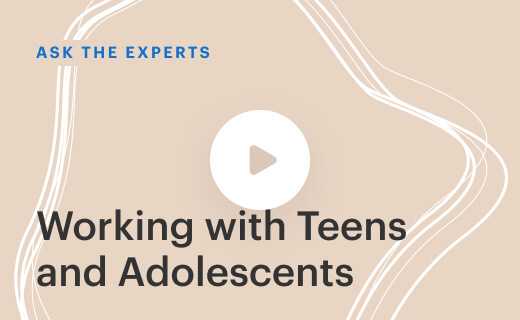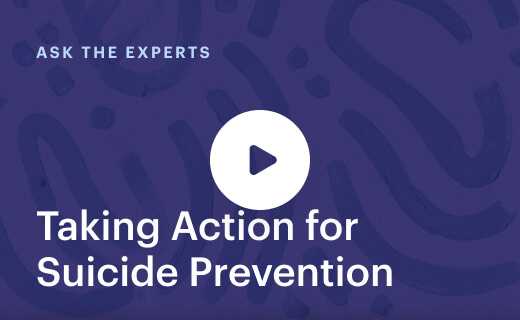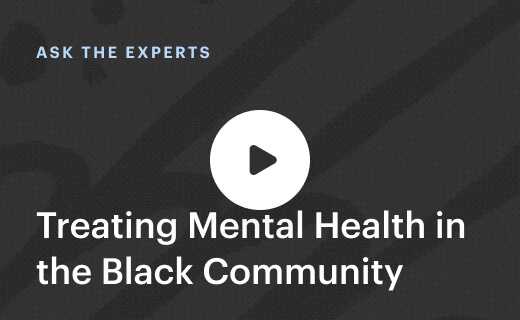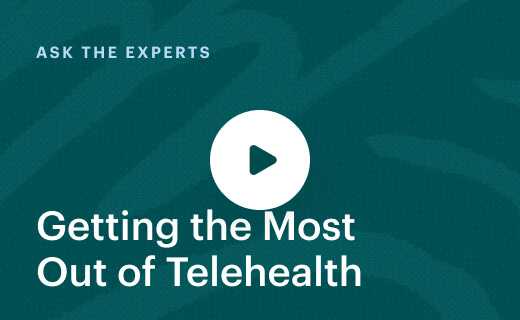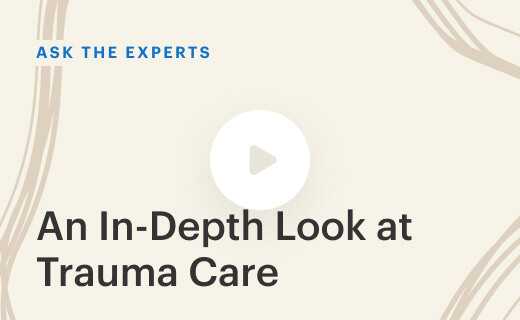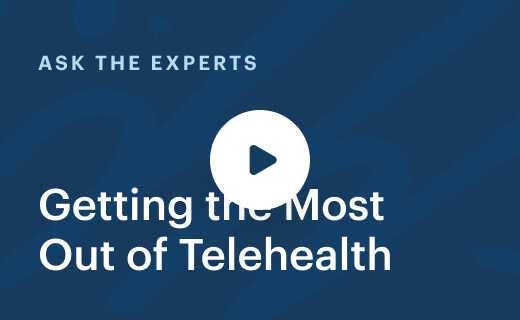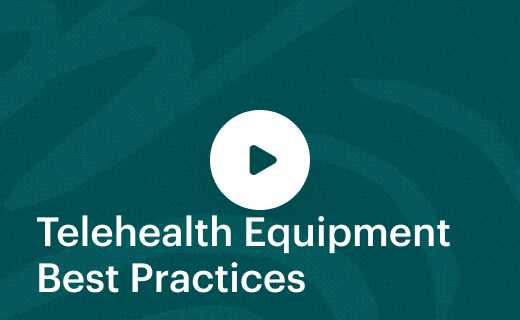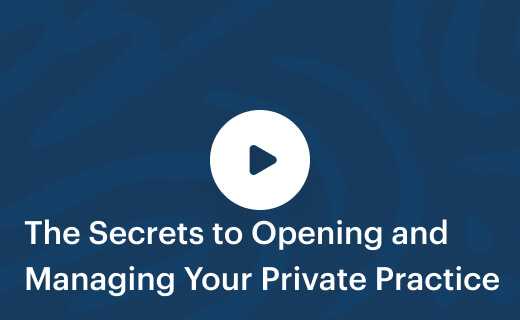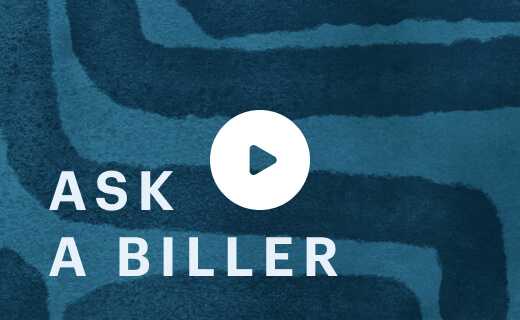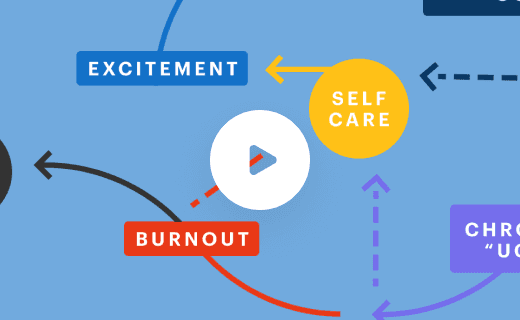Getting the Most Out of Telehealth: for OTs and SLPs
Free 30-day trial, access all this & more:
Want to know about other great webinars?
Join Jill Shook, MS, CCC-SLP, Katie Brown, MA, CCC-SLP, and Reina Olivera, DrOT, OTR/L, as they discuss everything you need to know about conducting telehealth appointments as an OT or SLP.
Hosted by Dr. Ben Caldwell, this group of experts share everything that you need to have in place before starting your first telehealth session, and best practices with keeping clients engaged through virtual appointments. They also offer insight on how to work with clients of all ages, and what to do when technology problems arise during your telehealth appointments.
No matter where you are in your virtual private practice journey, there are many advantages when it comes to offering telehealth appointments as an SLP or OT. Throughout this webinar, you’ll hear about the experiences from each of the experts, and ultimately how to give the best care to your clients—even if you’re not together.
- Introductions
- What are the most important details to know before starting your first telehealth session?
- How do you provide telehealth to geriatric patients?
- How do you provide dysphasia therapy via telehealth?
- What kinds of assessments do you use?
- Other than sort of the standard maybe headset and camera, is there other equipment that would be especially helpful for folks to have?
- How do you collect reimbursements for telehealth?
- What are some best practices for encouraging parent or caregiver participation in telehealth?
- How are you marketing your telehealth services?
- How do you make the experience more interactive on telehealth?
- What is your overall impression of insurance coverage for telehealth services at this time?
1. Introductions
Benjamin Caldwell: Well, good afternoon, everyone. I want to welcome you to today’s Ask The Experts webinar on Getting the Most Out of Telehealth. We are honored to have three very skillful telehealth practitioners with us today. We’ll do introductions here momentarily, but first, just a couple of administrative things. If you have questions as you are listening to today’s webinar, please go ahead and put them in, in the questions window here in GoToWebinar. Also, there will be a recording of today’s webinar that is sent out afterwards. So if you hear anything and think, “Oh, that was wonderful. I want to capture that,” don’t worry, you’ll have the chance to listen to it again.
Let’s do some introductions here. Our OT and SLP experts. First, Jill Shook owned a private practice in Pittsburgh. You can read about her a little bit more here, but Jill, would you like to introduce yourself briefly?
Jill Shook: Sure. So hi guys, my name’s Jill. Like Ben said, I own a private practice in Pittsburgh, which is hard to say 10 times fast. I have been doing teletherapy for the past three years, and I’m really excited to talk with you guys today.
Benjamin Caldwell: Great. Thank you, Jill. It’s good to have you. Next is Katie Brown, a speech language pathologist in Buffalo. Katie.
Katie Brown: Hi, everyone. I own a private practice in Buffalo called Neuro Speech Solutions. Traditionally, I see patients in their home, but due to COVID-19, like most of you, I’m guessing that you needed to switch to telehealth, so I can help you with any questions regarding adult therapy and also making the transition.
Benjamin Caldwell: Great. Thank you. Finally, Dr. Reina Olivera, an occupational therapist. Reina, where are you? You’re muted right now.
Reina Olivera: I’m in South Florida.
Benjamin Caldwell: Okay, great. Would you like to introduce yourself?
Reina Olivera: Sure. My name is Dr. Reina Olivera, and I am the owner of Telehealth OT Services, a strictly telehealth private practice specializing in children with autism who are homeschooled. Now my business has also shifted into helping occupational therapists be educated in telehealth and how to implement it.
Benjamin Caldwell: Wonderful. Thank you very much. This is more about me than anyone needs to know. I am the Education Director here at SimplePractice Learning and happy to be facilitating our conversation today.
I want to dive right into the questions. One thing quickly before I do for everyone in attendance, you’ll see there is a handouts section in GoToWebinar, and that includes some SimplePractice information about telehealth. There’s an appointment checklist, a resource directory, and a payer verification guide, all hopefully very useful information there that you can download at your convenience.
So with that, let’s dive right in. Our first question comes from Laurel, and it’s what are the most important details to know before starting your first telehealth session? Reina, why don’t we start with you on that one. Then we’ll go to Jill and Katie.
2. What are the most important details to know before starting your first telehealth session?
Reina Olivera: The most important details to know is what technology you’re going to be using and making sure you have everything in check with you and your client and having a backup. I think it’s really important.
Jill Shook: I agree. Yes, definitely having a backup. Oh, I’m hearing an echo. I hope I’m not echoing for other people. Yes, having a backup of anything that you might need. So having, if you’re working with kids, having extra toys that they might want to see, making sure you go over with clients what the backup plan is for if/when your computer freezes or their computer freezes or they lose the connection or the dog knocks the computer over or the kid dropped the iPad in the toilet, which has happened before. So yeah, making sure that you’re prepared, not only for yourself as the clinician, but also preparing the parent or aide for the client ahead of time to know what they need to look for. That will help with a lot of frantic texting and frantic calling for when and if things go south during a session.
Katie Brown: So I might add for anyone working with the adult or geriatric populations, having a conversation with either the client themselves or the caregiver on their willingness and ability to use technology and engage in telehealth. Also, if you are billing through insurance, to have that information if telehealth is even covered and if it is, what types of things you need to document and along those lines.
Benjamin Caldwell: Great. Thanks to all of you. Our next question comes from Rebecca, and it’s how do you engage younger clients, particularly children and teenagers through telehealth? I’ll tell you, I’m in the behavioral health world and a psychotherapist, and this is one of the questions that we’ve seen the most there as we’ve been transitioning to telehealth is how do you get younger folks engaged. Jill, I’ll start with you on this one. And then, Reina, I’ll come to you.
Jill Shook: Okay. So I like to think kind of outside the screen when I do telehealth as far as bringing materials that I’ve used in face-to-face therapy with them, as well as asking them to bring materials to speak to our session. So I’ll have them bring a favorite toy or show me their dog or that sort of thing so I can kind of bridge that divide because a lot of kids are used to a computer or used to a tablet, which is sometimes they’re even using phones for telehealth. They’re used to that being a fun machine. They get use it and they get to have fun with it. They don’t expect it to be work like speech therapy. So to engage them, you kind of have to bring in that connection with them. So the connection to their toys, the connection to their family, what they’re doing, a favorite thing that they have. So they can kind of see that this is not just getting to play with puzzles on the iPad. This is actual therapy.
Then just bringing in things that they like. So for instance, if I’m working with an older elementary age client, we can talk about Roblox or the computer game that they like or something. We can watch a little video and use that to target goals on what they like, just like you would do with face-to-face therapy, bring in kind of the client’s interest. You can just use screen sharing to bring that up for them so you can both view it. I found that goes a long way toward helping clients be more engaged with teletherapy.
Reina Olivera: Yeah. I agree 100%. Building rapport is so important. I think people think that in telehealth that you don’t really need to do that, but it’s even more important to be able to relate to your client and trust that you can develop a meaningful relationship through the screen. Then I guess from my perspective is that I don’t necessarily try to engage a child to the computer, but more so focus on the child and parent interaction from an OT perspective. My focus is not engaging them, but really making sure that the parent is engaging with them, and I’m just on the screen watching.
Benjamin Caldwell: That’s a great point. I’m curious, and Katie, this is for you too, the initial kind of process of relationship building when you’re having somebody who’s coming in for the first time or maybe the first couple of times, are you finding it to be markedly different when you’re doing it through telehealth versus how it might be in person? I guess Katie I’ll start with you and then, Jill and Reina, I’ll circle back to you.
Katie Brown: Sure. So absolutely. I notice a difference between telehealth and being in person, because there’s nothing quite like being in person, but there’s certainly still ways that you can build that rapport. One of the ways that I do that initially with anyone who’s new is by making sure that I do a really person-centered assessment. So I’m not just saying, “Answer yes and no to all these questions,” and formally going through everything, I’m using things like rating scales and asking them about their goals, what they like to do, asking about their family, what types of things do you want to get out of speech therapy. I think that makes it person-centered and it makes it less formal and scary like an evaluation might seem. I find that’s a good way to break the ice as far as telepractice and not being able to actually physically be with someone.
Jill Shook: Oh yeah. I agree. Yeah. To kind of talk about what Katie said, I also really like to have a very structured session. So I always tell them ahead of time what we’re going to do. “We’re going to do this activity so that we can target this goal.” Or, “We’re going to work on this,” because I’ve had the ability to work with, since I’ve been doing telehealth for more than just during this time when we all kind of had to and people are jumping into telehealth, patients are jumping into telehealth kind of not knowing about it.
I’ve had clients who approached me for telehealth, so I’ve been able to see that difference between someone who kind of knows what they’re getting into and someone who’s had to start telehealth as a patient without knowing what it is. I always really try to do a structure for each session and they know what we’re going to start with. We always start with the same kind of activities and we move through them in a specific way so they know what’s coming next. I think that really helps get them comfortable with kind of starting telehealth.
Reina Olivera: Yeah. For me, I think in today’s day and age, most people are comfortable with FaceTime or WhatsApp or whatever other video calling that you do with families. I try to tell the families that I work with, “Pretend like you’re talking to your best friend on FaceTime. I want you to feel comfortable.” I think the more that I relax and am comfortable with them and just make it feel natural, the more they’re able to open up with me.
Benjamin Caldwell: Yeah. That makes a lot of sense. It seems like clients and patients certainly take their cues from us about sort of how concerned they should be about telehealth and how much they should be bothered by the fact that it’s not an in-person session. Our next question comes from Paula. How do you provide telehealth to geriatric patients? Katie, I’ll start with you here.
3. How do you provide telehealth to geriatric patients?
Katie Brown: The first thing that I do is if I get a call or an inquiry for telehealth for a geriatric patient, I ask how familiar they are with technology. Typically, it’s their family member that is reaching out to me. You may be surprised, I’ve seen clients who are in their 80s with smartphones that are doing things that I didn’t even know was possible, but I’ve seen the exact opposite too. So I wouldn’t immediately eliminate someone who is unfamiliar with technology as ineligible for telehealth.
I’ve had numerous clients that are able to interact just as if I was with them in person. Some tips that I recommend is it’s very helpful to have a caregiver with them to set up the telehealth session initially or maybe permanently every session they may need to help and set up with that. I always send out an email prior to our session with recommendations for using telehealth successfully. Specifically with the geriatric population, you may have people who are hard of hearing, so you could recommend an extra speaker or headphones or something along those lines to make sure that they’re able to access the audio. Also, camera. You can think about things like positioning for a wheelchair or something along those lines so that it’s nice and clear. They can see the screen, what they’re doing and all of those types of things.
There’s, let’s see, even accessing the telehealth session itself can potentially become a goal depending on the deficits that the person is having. If they’re having trouble with sequencing and they have more cognitive issues, I think it’s completely appropriate to walk through the steps on, “Okay, how are you going to get on our telehealth call,” and be able to target that as a goal itself. So those types of things are really great for being able to work with geriatric patients and making them feel more comfortable with it too.
Benjamin Caldwell: Now, Katie, do you want to talk at all about Medicare billing for this, or is that too big of a can of worms to open up here?
Katie Brown: I can certainly talk about Medicare billing. I think that we have a question in a little bit that’s about insurance and reimbursement, but Medicare billing is … The lucky thing is that SimplePractice makes it quite easy to send electronic bills, but there’s been a big debate on getting us set up as distance providers, and we finally have. I have received reimbursement from Medicare at this point so I can speak a little bit on it as far as the codes that you need to use and all of that. I can address it now or I can address it in a little bit if you’d like.
Benjamin Caldwell: Let’s get there in a few minutes, but I did appreciate … I wanted to mention that you’ve been able to do it successfully, which I know is often a concern for providers trying to figure it out.
Katie Brown: Yeah, there is a way to do it. It is not impossible.
Benjamin Caldwell: Okay, good. Reina, Jill, anything you wanted to add about engaging with geriatric patients?
Jill Shook: No. I think Katie covered everything. That was great.
Benjamin Caldwell: Then our next question is from Lauren. How do you provide dysphasia therapy via telehealth? I think again, Katie, we’ll start with you there.
4. How do you provide dysphasia therapy via telehealth?
Katie Brown: Okay. Yeah. So I’ll take this one again. Dysphasia therapy can absolutely be done via telehealth, and there is actually research to back it up too. Is providing this type of therapy challenging via computer? Yes. Is it right for everyone? No. It’s got to be again, like everything we do, very patient specific and person specific. There’s a researcher. Her name is Dr. Georgia Malandraki. She’s with Purdue and her I-Eat Labs. She has put out of a full page of wonderful resources on how to provide dysphasia teletherapy. So I’d highly recommend looking it up if that’s something you plan to pursue.
But I can certainly give you some helpful tips on how to successfully provide dysphasia therapy, whether it’s an evaluation or treatment. So the first recommendation is there needs to be a facilitator. There needs to be someone on the other side. If they live alone, then I wouldn’t say that they are appropriate for dysphagia therapy via teletherapy, just for safety issues because we are working with people who are having trouble swallowing. You don’t want them aspirating, choking, something along those lines and having no other person there for assistance. So there needs to be some sort of facilitator on the other side.
You can train the facilitator to do things such as help you with exercises, move the camera so that you can get frontal and lateral views, doing things like administering PO trials if needed, and you can speak with them beforehand so that they know when to intervene. You can have a hand signal, “Go and do that for me,” or you can just talk it through.
Another thing that I find very useful is having short videos made up of whether it’s of exercises or cranial nerve assessment, something along those lines. Having those that you can share either beforehand or share via screen share in the moment will just help with overall education and comprehension of what you’re asking someone to do.
Some other just simple tips that I find are helpful are using clear cups if you’re drinking so that way you can kind of judge how much someone’s taking because it’s difficult if they’ve got a cup that’s red and solid and you can’t see through it. You can have the facilitator use asynchronous methods. So like telehealth is typically synchronous, asynchronous would be if someone sends a video to you. So I might ask, “Hey, at dinner tonight, can you take a short two-minute video of your wife eating?” Just so that I can see what it’s like in the natural environment when it doesn’t feel so clinical and like, “I’ve got to perform and do this right now.” There’s a lot of ways that you can make dysphasia therapy work. It needs to be highly personalized and come with clear instructions on how to complete strategies, exercises, and adaptation. Sending out checklists and step-by-step protocol is going to be very important in this aspect.
Benjamin Caldwell: Great. Thank you. Reina or Jill, did you want to add anything on that?
Reina Olivera: I think from a safety perspective and also with geriatrics, I mean with all populations I think it’s important to make sure that you have, like Katie mentioned, a safety protocol in place so if something happens that they know that you’re not responsible for calling 911 and that they should have some kind of emergency system in place, especially with swallowing and geriatrics.
Katie Brown: Yeah, absolutely. I always have a backup plan like Jill and Reina, both of you mentioned in the very first question, there’s a backup plan and it’s different than if I’m doing speech or cognitive therapy versus swallowing therapy. It’s certainly going to look different.
Benjamin Caldwell: Yeah. That makes a lot of sense. Let’s go to our next question then. It comes from Erica and it’s kind of a big, broad question. What kinds of assessments do you use? So Jill, why don’t we start with you here? And then we will go to Reina and Katie.
5. What kinds of assessments do you use?
Jill Shook: Okay. So this is kind of the age-old question that we often get even in face-to-face therapy because we have tests and then we have other measures that are not standardized, informal measures, language sampling, that sort of thing that we can use, dynamic assessment if you’re assessing someone who is bilingual or if you have students who don’t kind of match with any of the tests that we have. That is the same issue that we have with testing via telehealth because there are only a few tests, and Reina, I’m not sure about the OT tests that you use, but for speech, there are very few tests that have been validated for use with teletherapy officially. So currently the ones that we SLPs would be using, the Goldman-Fristoe, the PPVT and EVT and the CELF-5 and CELF-5 Metalinguistics are all available to use and they have been validated for use.
They haven’t been standardized for use. They’ve been validated for use via telehealth and Pearson, which is the publisher of those tests, they do have the information on their website. They walk you through, they have videos of how to do it. They have an online assessment portal that you can use. So you can use those options. But if you wanted to use, say the PLS or another test that isn’t available, you would have to choose to do so in a non-standardized manner, which means you can’t report the scores as standardized. If you’re trying to do a test for insurance eligibility or school eligibility and you have a certain benchmark that you have to meet, a certain score cut-off, it’s a little bit tricky because you can’t be using those as standardized scores, even in some cases with the tests that have been validated for use with teletherapy.
We don’t have a perfect world. We can’t control the clients’ studying environment so there’s been times where the parent will start answering the question, and we’ll kind of invalidate some of those or the dog will start barking or something will happen to the connection and we have to take a break in the middle of the test and we shouldn’t have to do that. So all that to say, you can use the type of assessments that you would choose as the best assessment for that client, just like you would in person, keeping in mind the standardization and the validity of those assessments might be affected by the environment that the client is in.
Benjamin Caldwell: Okay. So this has come in live while we’ve been talking here and it relates to what you were just saying, Jill. See if I can sort of understand the meaning here. As it relates to those non-standardized tests, so where you might not be able to report norms, does it still make sense to use them to demonstrate sort of clinical change?
Jill Shook: Oh, yeah. Yeah, I’m a big fan of non-standardized measures as far as tracking progress and sometimes just getting a whole picture of the client beyond what you can see in a standardized measure because that’s obviously not the whole picture of any client. It’s a snapshot in time. So yes, I would definitely say you can use those non-standardized measures, use criterion reference measures, use handouts or tests that you can … Self-reports, that’s what they’re called … Self reports or reports and questionnaires you send to the parents or caregivers. So yeah, use those. Then you just have to be very careful in your report, how you’re writing it up, mentioning the environment that they were given in, that the testing was done via telehealth, whether the test itself was validated for use via telehealth and why you think that it’s important. “I’m using the PLS,” whatever portion, “Because it measures receptive language better than a different test.” Or whatever test you’re using, just to have that piece of information that you feel that, that test can give you that another test can’t.
The short answer is yes. Go for all those informal measures as long as you document them correctly.
Benjamin Caldwell: Okay. So just maybe a little more contextualization and a little more in the way of cautionary notes.
Jill Shook: Yeah.
Benjamin Caldwell: Okay. Reina, what about you? I know that your work’s a little bit different. In the world of OT, what assessments are you using via telehealth right now?
Reina Olivera: So Jill mentioned Pearson and there’s also WPS Publishing that have both put out digital assessments that can be used via telehealth, such as … I’m going to also list the alphabet soup here … The REAL, R-E-A-L, the PD-CAT, SPM, Sensory Profile, Violin 3 and many others. For my practice personally, I don’t really use standardized assessment tools. I rely more heavily on observation and asking the parent what they’re struggling with and then try to use goal attainment scaling to create my goals in collaboration with the parent and go from there.
We’ll talk about this a little bit later, but I don’t submit to insurance, and so I don’t need to rely on those standardized assessments. But I’m really glad that Jill brought that up because it’s something that’s not talked about and people want to use tools that maybe seem appropriate for telehealth that you can do and that are standardized, but they haven’t been standardized for telehealth. So definitely proceed with caution on that. But there’s a lot of occupational therapy assessment tools that are now digital, and it’s amazing to see what’s come of it. Especially now, these companies are providing discounts and they’re providing more guidelines to how to give the assessment tools via telehealth.
Benjamin Caldwell: Okay, great. Thank you. Katie, what about you? What assessments are you using?
Katie Brown: So like Reina was saying, I do a lot of goal attainment scaling and everything like that as well. My assessments haven’t necessarily changed too much at this point because I love doing person-centered therapy assessments. I love using things like rating scales, which can be standardized. You can find them available in research articles. One of the most popular ones that I use is the Patient Competency Rating Scale. So you can find it freely online. It has a patient and a caregiver section so they can rate their skills in various areas. You can look for discrepancies and see a lot about insight into a client’s deficits just based off of comparing the two.
Just a note, if you are going to use, because Jill and Reina, you were both mentioning online tools, tools that have been adapted and are currently already online. Although again, they’re not necessarily validated for telepractice, one cool thing that I’ve learned is that if you have say the scoring sheet or the stimulus book, but you can’t hold it up in front of the camera. It might have a glare. There might be something going on. One thing that I learned is that you can invite essentially another device to your session. So if it’s your phone or a tablet or something, you can invite it to your session and you can have it looking at the book so that way they can still see you, and then they can see the assessment as well, like the stimulus book. That’s a way that you can use physical copies of assessments to be able to use them in evaluations.
Jill Shook: To touch on that, Katie, I use a document camera. They have specific document cameras, and I like document cameras specifically because they have some that have a tray or yeah, kind of like a tray or a piece of kind of plastic under it that shows you what the size is that it can see. So you’re not having to figure out where to put the book or anything. If it’s in that gray square, then the client can see it. So you can get document cameras online for, I think about $80, and I found it to be a really good investment to keep me from juggling things, because there’s very little that’s less professional than holding up a book to the camera and being like, “Can you see that? Can you see it? There’s a glare.” So yeah, I agree.
Benjamin Caldwell: That actually, that raises a related question and it’s about equipment. So a lot of folks have been transitioning as quickly as they can to telehealth. For somebody who’s an SLP or an OT who is making this transition and they’re trying to figure out equipment stuff. So maybe a document camera is going to be helpful. What else? Other than sort of the standard maybe headset and camera, is there other equipment that would be especially helpful for folks to have? Jill, I’ll start with you and then Katie and Reina.
6. Other than sort of the standard maybe headset and camera, is there other equipment that would be especially helpful for folks to have?
Jill Shook: Okay. Yes. I’m kind of a minimalist when it comes to things. I haven’t even used the document camera for that long. I had tried to set up my phone and stuff, and that’s how I learned. It was really clunky to try to use that if I had the option. I really like to use a desk cycle, which is not specifically for teletherapy, but it helps me, you just put it under your desk and you could pedal away while you’re sitting there and talking with people. I find that very helpful for my mental health while I’m doing teletherapy so I can get a little bit more movement in. That’s equipment that I like.
I also really enjoy having a desk riser on my computer desk for teletherapy because it gets my computer up so I’m not kind of leaning over it. It’s eye level, and I think that that works really well. It has little nooks and crannies I can put things in because it’s helpful to have that on your desk. So a desk riser or something you can raise your computer up on and then some sort of, they have under desk ellipticals you can use. But I like my desk cycle for that too.
Benjamin Caldwell: Reina, what about you?
Reina Olivera: So I get asked a lot about dual monitors and if you need two monitors, one to document and one to see your client. That’s an option that I want to mention. Personally, I was gifted an iMac, so it’s a large screen and so I can just divide it. I can put my documentation on what happened and one of the other. If you have unlimited funds, I would totally say, go with a large monitor. Setting up two monitors can get kind of messy. I just like the clean one monitor and it works well for me. I couldn’t really imagine doing it on a laptop like a lot of people are doing because they have to. They didn’t have the time to go shopping, but yeah, either dual screen or a large screen, I would say is my equipment recommendation.
Benjamin Caldwell: I know that one of the cautionary notes that we have to add in here right now is that it’s really hard to find video conferencing related equipment right now because there’s been such demand for it. But Katie, any equipment recommendations?
Katie Brown: The only thing I was going to add was the dual monitor. Reina covered that. Maybe a comfortable chair. The first month that I was doing this, I had a terrible chair and I switched it out and I’m much happier now.
Benjamin Caldwell: It’s amazing what a difference that kind of thing can make. Our next question comes from Joanne. How do you collect reimbursements for telehealth? I know that Katie, you started talking about this a little bit earlier, but for everybody what’s your process look like for collecting reimbursement these days? I guess. I’m sorry, Jill, I’ll start with you.
7. How do you collect reimbursements for telehealth?
Jill Shook: Okay. So it depends on if you’re working with insurance or doing private pay. So I will speak to insurance because I know Katie and Reina are able to speak to other aspects like private pay and Medicare. As far as insurance, again, because I’ve been doing telehealth for a while, I’ve been getting reimbursed for that time, which has been really, really nice. I’m hopeful in the future it will be easier to get reimbursed. But I think in general, the process is the same.
Always check either via the eligibility portal with the insurance or calling, if they still have a number. I know a lot of insurances don’t give you the number or you can’t find the number or they don’t usually answer the number. But call and try to talk to someone and ask for the specific CPT codes that you will be billing with the telehealth modifier. Ask them what telehealth modifier they would like you to use because there are a couple. Some like to use GT, some like to use … There was another one. There’s GT and-
Katie Brown: 95.
Jill Shook: 95. Yes. I was blanking on that one. Sometimes they’ll cover one, but won’t cover the other, even though they’re basically the same. There are some other codes that I had seen on ASHA that Medicare and Medicaid might be using. But that depends again on Medicaid in your state. It could be different. So call them say, “These are the codes I’m going to be billing. 92507 for general therapy. What telehealth modifier should I be using for this?” And then also ask them what place of service they would like to use because in general, you use 02, which is synchronous audio video conferencing software. It’s the long name that CMS came up with. But sometimes they want you to use 11 for office, confusingly, even though you’re seeing the client via telehealth, they want you to use 11 for office because you’re in your office and it can get confusing.
So my number one requirement is call them, ask them specifically, what code do you use as far as CPT codes, modifiers, and then place of service codes because that will solve many of the problems you’d have down the line when you’d send them in and the biller doesn’t know what GT means, or you send them in and the biller doesn’t know why it’s listed as 11 or 02. So get that in writing, write it down, have it down, photocopy it so that you can send it if they deny your claim.
That’s kind of all the legwork you have to do. I mean, I use SimplePractice and it makes it so easy to just fill out the form. And now you can just add the modifiers right there when you do the appointment, and it automatically updates to the claim form, and then you can just submit it. It’s really easy once you get that, front end out of the way as far as verifying telehealth coverage.
Benjamin Caldwell: Ah, the joys of working with insurance. Reina, what about you?
Reina Olivera: So I have a unique situation. I’d say my practice is cash based. And part of it is, but what I want to share today is that in Florida, there’s a scholarship that parents of children with autism primarily and some other diagnosis get, and they can use the funds from that scholarship to pay for my services. That is how I get reimbursed. I became a direct provider through that scholarship, and then I submit the reimbursement to them and they pay me directly. And it’s under that child’s ID. I know there are a few other states, I believe Arizona, New Mexico, maybe California, have something similar. And so I just wanted to throw that out there as an option that you could have in your state.
Benjamin Caldwell: Great. Thank you. Katie, what’s your reimbursement process look like these days?
Katie Brown: Yeah. So Jill hit the nail on the head as far as calling and asking, “What exactly is it that you want me to bill?” Because it’s going to be different for every insurance company. I always get a reference number at the end of the call so that way if there’s any issues I can say, “Well, according to this reference number, I billed correctly,” things like that. But as far as Medicare, so far I have been reimbursed, and I will tell you how I’ve been reimbursed. That is by using not 02 for place of service, even though you would think that it would be. I use 11 for office and that’s what worked. And then I used GT and then also the specialty modifier. So speech therapy is GN. OT, I think is GO. PT is GP. So you need to have that modifier still.
I use GT. I’ve heard of other people saying that using 95 instead of GT, they got reimbursed as well, but I’m going to speak to my experience, which is that I used place of service 11 for office, I use GT for telehealth, and I used GN for speech therapy and I was reimbursed. That’s all I’ve got to say on Medicare. But you can always call your MAC and see exactly what it is that they’re looking for because it might be based off of which Medicare administration actually does your billing. I’m in New York with NGS Services. That’s my MAC. Just so you all know.
Benjamin Caldwell: Jill, what were you going to add there?
Jill Shook: I’m sorry about that. I was just saying that, yes, I’ve always used GN as the modifier as well. So I should have mentioned that. Some people who have talked to me personally have been confused about stacking modifiers, but you can use up to four modifiers per CPT code. So you can add GT or 95 and then still use GN, which is what you’d use for the speech therapy plan of care anyway. So you can use both of those.
Benjamin Caldwell: So speaking of some of the sort of more, I guess, procedural or administrative elements of practice here, a question came in on the live chat. Does telehealth change anything with liability insurance? If we’re doing telehealth now, should we be contacting our liability insurance carriers? Reina, I’ll start with you. Did you talk with your liability insurance and what did they say?
Reina Olivera: I started my practice all telehealth, but definitely when I spoke to … I have proliability by Mercer. When I spoke to them, that definitely wasn’t a question that I wanted to get clarified. I definitely recommend anyone who has switched over to call or who was planning on switching over to call their liability insurance and make sure that telehealth is covered.
Benjamin Caldwell: That makes good sense to make sure that in this area of practice, that your liability insurance would cover that area of practice. Jill, what about you? Was it just a simple phone call? Were you already aware of your liability insurer covering telehealth or how did that work you with liability insurance?
Jill Shook: So I have proliability from Mercer too. The one that you can get through ASHA with your ACE discount. And yes, I just called them because I provide in home services as well, and that’s what I started doing and then had transitioned to telehealth and now it’s all telehealth for the foreseeable future. So yes, I called them and had that added onto my policy just so they understood that I had both of those areas because I don’t need a general liability policy for an office because I don’t have an office. I just need professional liability. But they do have an addendum they can add on for telehealth as well.
Benjamin Caldwell: Great. And Katie, what about you?
Katie Brown: I don’t have anything to add. You have to call and make sure that telehealth is covered and under your policy.
Benjamin Caldwell: That’s funny, when you started saying that, I thought you were going to say, “Oh, I don’t have any liability insurance.” I was going to say, “No, Katie. You have to.”
Katie Brown: No, I work with therapy and I have no liability insurance. Not a smart idea. Get liability insurance.
Benjamin Caldwell: All right. Our next question here comes from Alec. What are some best practices for encouraging parent or caregiver participation in telehealth? Reina, why don’t we start with you and then Jill and Katie.
8. What are some best practices for encouraging parent or caregiver participation in telehealth?
Reina Olivera: Sure. So I think the biggest thing here is communication, communication, communication. I think if you set the groundwork by telling the parents what your intentions are, what your model of treatment is, and making sure that, that’s all clearly laid out in that first appointment or even before the first appointment, then you’ll have better success. Also, within that, highlighting what the benefits are for them to participate in. For me, I want them to become empowered to provide their interventions with their child when I’m not there. I think clearly identifying the benefits and showing them why, and having that communication is key to having a successful parent or caregiver interaction.
Benjamin Caldwell: Great. Thank you. Jill, what about you?
Jill Shook: Yeah. I agree. Setting the groundwork ahead of time … I mean, as a parent myself, I like going into an appointment knowing, “This is what I need to do,” and not just sit there going like, “I don’t know what to do with my hands? What am I supposed to do while my child’s doing whatever this therapy is.” So yeah. Laying the groundwork and setting out what your requirements are and letting them know. A lot of times I’ll be talking to the parent more than I’ll be talking to the child like Reina was saying. Or Katie, like you were saying, you’ll be coaching the caregiver on how to provide or move or support the client that way. So yes, being very clear about what the expectations are, because a lot of parents don’t know that they are needed there for telehealth. They think they just sit their kid in front of the computer and then kind of like go do the laundry and come back.
Benjamin Caldwell: Hey, free babysitter for a little while.
Jill Shook: Yeah. Basically. So yeah, making sure you have the expectations very clear, and then also what’s going to happen if they don’t do that. “The expectation is you’re here with your child. If you’re not able to do that, we’ll need to reschedule, or you might need to wait until we do in-person therapy again. Maybe telehealth might not be a good option for you if that’s not something that you can do.”
Benjamin Caldwell: Great. And Katie, what about for caregivers, especially if you’re working with geriatric patients? How do you go about getting them involved?
Katie Brown: Yeah. Like Reina said, you want to empower them. You want to empower the caregiver. You want to empower the client as well. I always mention that, although the client is the one that has the communication disorder, it has a wide-reaching effect on family and friends as well. They’re noticing differences. Their husband isn’t able to talk to them like they used to be able to, and the only way to teach them to be able to adapt their communication style is by having them present. That is definitely an integral part of what I do.
I always request that, for at least the majority of the session, that there is a caregiver there, whether it’s a loved one, a friend, something along those lines, someone who they communicate and interact with on a daily basis is something that I find very important and vital actually to therapy success in general.
Benjamin Caldwell: Yeah. That makes a lot of sense. Our next question comes from Sharon. How are you marketing your telehealth services? And Katie, why don’t I stay with you here to start with and then Reina, then Jill.
9. How are you marketing your telehealth services?
Katie Brown: Sure. So first thing that I did was I wrote a blog post on what it means to do teletherapy. I sent out an email to all of my existing clients explaining what teletherapy is with a link to that blog post so that everything was all set up and they could kind of understand what it means to do it. I spoke with my existing clients at length to see if it was right for them. Additionally, as far as any new referrals, I called all of the physicians that refer to me in my area and let them know that I’m now providing telehealth services. Put a big banner across my website page so that whenever anyone clicks it, it says up front providing telehealth therapy due to COVID-19 pandemic, click here for more information, call this number to schedule, along those lines.
Reina Olivera: Yeah. So my method is I feel completely different than what Katie mentioned, which is great. That’s understood.
Katie Brown: Yeah. I’m like the transition. So Reina, we have a completely different experience.
Reina Olivera: Yeah. For me, all of my marketing efforts were through social media. I’m doing telehealth, and I expect people to be online so I’m going to market to them online. I attempted to go the physician route and it didn’t serve me well. Not saying that it doesn’t, it didn’t really work for me. I stuck with the social media route.
Well, whenever I asked for marketing advice when I started my business, people were always saying word of mouth. And I’m like, “Well, how do you get that one client in order for it to start trickling out?” After that, I just realized you have to tell everybody about your business, talk to all your friends and family, see who they may know. And then through social media, being on Facebook, being in groups where your client may be and showing them that you’re an expert in whatever problem that you’re going to be helping them with. And then just building connections and just building relationships with people.
Reina Olivera: I think that’s really the key focus, especially in telehealth because people, if they’re not transitioning from in-person to telehealth, they’re going to have a hard time trusting you through online because there’s scammers and et cetera. So really building relationships with people is key.
Jill Shook: Yeah. Yeah. Totally. Like you were saying, Katie, we have a transition because I’ve been doing in-person … I’ve had my private practice for five years and I was doing in-person, but I’ve also had telehealth, so I’ve kind of been riding that wave of marketing telehealth before it was a thing, before it was cool, before people knew what it was. I can say it was a lot harder to even share about telehealth with clients, for them to even understand what I was talking about really a year ago than it was last month. So now people are much more open to it now that their doctors are doing it.
So as far as marketing, the pandemic is kind of doing a little bit of marketing for us as far as getting people to understand what tele-health actually is. And then making sure, like Katie was saying, anything online, because again, they’re going to be online so your website has everything updated about telehealth. I’ve written a blog post as well so I link that on my facing page of my website. They log in, this is how I offer therapy, it’s underlined and links to the blog post about what is telehealth. And then I talked to my clients about it, so they understand it. And then I also made sure my Google My Business page, which is that page that comes up whenever, if someone Googles you right there on the right, it’ll have your picture and your map of where you are and everything and your hours. You have to make sure that’s updated as well and make sure that you put telehealth on there as well.
I haven’t seen with any of the insurance providers that I’m with, where on their insurance provider website, they’ve updated a place where you could add telehealth as an option. But I foresee that they’ll be doing that in the future as parts of other medical professionals start adding that to their repertoire as well. Because a lot of people, psychotherapists and counselors and everyone, are going to be keeping that in their rotation as far as how to provide therapy. So I think that, that’ll be good as well to have that.
Benjamin Caldwell: Yeah. A lot of the therapists I know are really wrestling right now, with the choice of whether to reopen a physical office or whether to just practice online here going forward. Staying on the question of marketing just for a second, because when you’re doing telehealth, you don’t really have the opportunity to hand out business cards, when this started, you all were, I think, pretty unique in the telehealth services that you offered, but now everybody’s doing telehealth. So with everybody doing telehealth, are you finding that you’re having to adjust some of your marketing to highlight other elements of your practice? Is it a different process of kind of generating word of mouth referrals? What adaptations have you needed to make since now everyone else is largely online as well?
Reina Olivera: I feel like I just got really lucky with the horrible situation because, and I’m going to tie this in to answer your question, but I wanted to highlight that the SimplePractice booking widget, and I’ve had that on website and it’s awesome. I’m like, “This is great.” But before coronavirus, I had maybe one or two people that used that and now people are going on my website and requesting appointments all the time. I think I haven’t really had to do anything. It’s just coming to me because of, like Jill mentioned, because of the pandemic.
Benjamin Caldwell: Yeah. You were lucky in that you had all the tools kind of already in place. Jill and Katie, have you made any other kind of adaptations as you’ve seen maybe more competition in the world of online services?
Katie Brown: I have a little bit. So my selling point was always that I come to your home, which is a huge selling point with the population that I work with. Typically, they can’t drive or they have difficulty getting out and about or they’re dependent on someone else, so being able to go directly to them is great.
But I think the new thing that I’m kind of focusing on is yes, I’m providing telehealth. I can come to your home after it’s safe, but also that I do therapy a little bit different than a lot of speech pathologists in the area. I don’t use workbooks. It’s your goals. We’re going to work on things that are functional for you. The impairment score may not change, your verbal expression score might not change, but you’re going to be able to order a coffee at Dunkin’ Donuts and that helps your quality of life and things like that. I think that’s definitely a wave and a surge that is happening in the speech pathology field right now, but not everyone’s quite on it yet. So that’s kind of more of my selling point now that everyone’s also doing teletherapy.
Benjamin Caldwell: No, that’s great. I can tell you’re East Coast because of Dunkin’ Donuts. Jill, what about you?
Jill Shook: So as far as changing, a lot of therapists in my area actually aren’t offering telehealth because many of them didn’t really know what it was before COVID happened. So thankfully I’ve already had that on my website. I’ve already talked to other clients about it. They’ve been able to refer people, “Oh, she does therapy this way. This is easy.” I mean, for a while I’ve had clients who do a hybrid model, so I’d see them once a month at their home and then the other three times a month via telehealth. I can work with that. So like Katie was saying, just like with regular in-person marketing, you can market what’s different about you, how you kind of have a niche, based on the other people in your area.
Benjamin Caldwell: That makes a lot of sense. It’s interesting that you haven’t had the same sort of degree of competition, it sounds like.
Jill Shook: Not really.
Benjamin Caldwell: So forgive my asking. I’m curious have people kept their physical offices open?
Jill Shook: No. Some places have closed, but closed their physical offices. But in general, they either just don’t offer the telehealth or they don’t offer it to all of their clients because their clients don’t want it. I’ve had a couple clients that just didn’t want to do teletherapy. Weren’t interested in it. They just haven’t been that much of an issue or the SLPs themselves were not confident in telehealth so they were referring other people. Because that is an aspect of telehealth is yes, if you have the ability to and you feel confident in it then that’s great. But a lot of what ASHA recommends and what our state professional companies recommend is if you’re not confident in it and you don’t feel like you have the skills, refer out until you feel confident enough to be doing teletherapy because it is a whole different therapy modality. So thankfully I have the skills and I have been doing it for a while. So people were confident to either refer to me or kind of put their practices on hold until they felt like they were confident with it.
Benjamin Caldwell: Yeah. That’s great. We’ve got just a couple of minutes left here today, so I’ll get a couple more questions. I’ll get in one more from the chat as well. This one comes from Jennifer. How do you make the experience more interactive on telehealth? Certainly with everybody being in front of a screen, it can feel very separate. It can feel very far apart. So what does each of you do to make it feel a little bit more like you’re in the same space together? Reina, I’ll start with you and then Katie and then Jill.
10. How do you make the experience more interactive on telehealth?
Reina Olivera: Yeah. So as I mentioned earlier, I try to tell them, “Pretend like you’re talking to your family. Put me down somewhere.” They actually say, it’s so funny, they actually say, “I’m taking you with me.” So I’ll say, “Take me with you. Let’s go outside, take me with you and I’m a person.” They’re picking me up and they’re picking up their tablet and they’re going. I think that that just keeps it light and fun and interactive in a different way.
There are other OTs who use applications and just different ways of interacting on the screen via the screen sharing and then connecting … Imagine using Google Docs and two people are editing it at the same time and sharing the screen so you can see the edits. So you kind of can interact like that. Using Jamboard and other websites that you can both connect to at the same time so that you can be working on the same thing and then sharing the screen that way. So those are some of the ideas that I’ve seen that work well.
Benjamin Caldwell: That’s fantastic. Katie, what about you?
Katie Brown: I liked that Reina. “Take me with you.” That’s fun. So screen sharing is a must for me. I often open up Google Docs and share it so that we can write down strategies, cognitive plans, anything that we’re working on. I also often mirror my iPad to my computer so that way you have the ability to use apps, which I find to be helpful as well.
Jill Shook: Yeah. Those are great ways to encourage interactivity. Yeah. I’ve definitely said what you said Reina, “Take me with you,” when they’re on iPads. We ask the clients to put us on computers, but that’s not always possible or functional. So yeah, we’ve been on the tablets before.
But yeah, screen sharing, I think is really important. There are options for platforms that have games and stuff like that. But I found that that can be a little clunky depending on your internet connection and the client’s internet connection might not work very well. That doesn’t encourage interactivity. That just makes everyone frustrated when you’re trying to play a game and it’s lagging or that doesn’t work. So, yeah. Screen sharing so you’re both looking at the same thing I think is the most important thing for making it interactive, and I’ve found having a client tell you, “Okay, so what do you want to look at next?” Or, “What part of this page do you want to look at?” And then they have to use their words and tell you. So I found that to be really helpful too.
Benjamin Caldwell: Yeah. Those are all really great ideas. In the interest of time, let me get one more question in here from the chat. It’s a broad question so you can go into as little or as much detail as you like. But the question is, I know every payer is different. But what is your overall impression of insurance coverage for telehealth services at this time? Katie, why don’t we have you go first and then Reina and then Jill.
11. What is your overall impression of insurance coverage for telehealth services at this time?
Katie Brown: Okay. So at this time… I can’t speak to anything beforehand… But at this time insurance companies in my area are reimbursing telehealth and they have end dates. The most recent one was the telehealth reimbursement will end on May 31st. That has since been extended. But I have a feeling that just the practicality of telehealth, especially for people who live rurally or someone doesn’t provide services near them, I have a feeling that a lot of these insurance companies are going to end up keeping telehealth reimbursement. Obviously I can’t predict that they will, but I think it would be advantageous for them to do so.
Reina Olivera: Yeah. I agree 100%.
Benjamin Caldwell: All right. Go ahead, Reina.
Reina Olivera: I agree with what Katie said. I think that in the midst of all the chaos, insurance companies and lobbyists and all the people in government have done a good job to get everything in order for especially I think OT, who was so behind in the telehealth space to get reimbursement for our services. We’re all hopeful that it remains this way for the future and not just for it to be temporary.
Jill Shook: Yeah. I agree. Like Katie and Reina were saying, currently I’m billing Blue Cross Blue Shield in Pennsylvania, and they’ve covered everything. I hadn’t had issues before with telehealth. I’d been able to bill that a couple of years ago and it was covered. So like they were saying, I’m hopeful that in the future, things will be covered as well as they see more of the utility of telehealth.
Benjamin Caldwell: Well, that’s great. Thank you all. I really, really appreciate each of your time and expertise here today. We got a lot of information into an hour, so I really, really appreciate what each of you has brought in. For those listening to the recording, we do have contact information for our presenters on those introduction slides back at the beginning. So if you have additional questions you’d like to follow up with them on, please feel free. I know that each one of these folks with us today is very generous with their time and answering questions.
So I just want to thank everyone once again. I know we are at time for the day. Reina, Katie and Jill, thank you all so, so much for sharing generously your time, your expertise and your wisdom today. I really, really appreciate it. On behalf of all of us at SimplePractice to all of our attendees, thank you so much. Have a wonderful rest of your day.
Build the best practice you can.
Our resources to help you & your practice take the next step.


